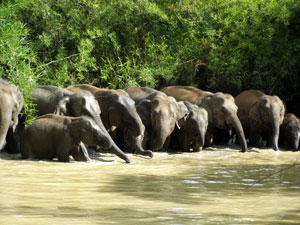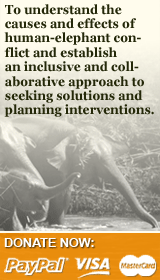ECN Mission
 |
| A herd of elephants in Salakpra |
Aim
The aim of the Elephant Conservation Network is to secure the future of Salakpra's elephants and their forest ecosystem for the sustained benefit of local people and wildlife.
The long-term aim of this project is to help safeguard wild elephants in Thailand's western forest conservation complex (WFCOM). The intermediate aim is to help safeguard elephants in the Salakpra Wildlife Sanctuary and Chalerm Ratanakosin National Park (part of WFCOM) by establishing a participatory system to monitor elephants and their threats and by introducing appropriate conservation interventions into the area. The aim of this phase of the project (1999-2000) was to find out what local people (forest guards and villagers) know about elephants in the area and what they think the conservation threats and problems are.
Objectives
- Monitor, map and measure the incidents of human-elephant conflict in order to provide the factual basis upon which to seek an effective and sustainable solution.
- Monitor the seasonal distribution and habitat associations of elephants inside the protected area in order to establish what links there may be to crop-raiding.
- Undertake human-elephant conflict mitigation measures, both to reduce the cost of crop-raiding and to offset the cost of living with elephants.
- As part of HEC mitigation, establish a system of crop-protection trials in the main HEC locations to find out which methods work best and are the most cost-effective.
- To help offset the cost of human-elephant conflict, establish a community-based ecotourism initiative that makes elephant ecosystem conservation an aim and an asset.
- Secure an effective forest corridor between Salakpra-Tham Thanlod and Srinakarin protected areas in order to prevent the total isolation of Salakpra's elephants.
- Monitor the land-use and socio-economic links to human-elephant conflict in order to identify areas most in need of mitigation and to enable the evaluation of interventions.
- In due time, investigate the potential for alternative sources of supplementary income linked to more sustainable systems of community-based natural resource management.
The Elephant Conservation Network is a community-linked conservation initiative that is seeking a sustainable solution to the problem of human-elephant conflict around the Salakpra Wildlife Sanctuary in Kanchanaburi province, west Thailand. Its ultimate aim is to secure the future of Salakpra's elephants and their forest ecosystem for the sustained benefit of local people and wildlife. It is supported by the Zoological Society of London's Conservation Programme with funds from the UK's Darwin Initiative, US Fish & Wildlife Service, Japan's Keidanren Nature Conservation Fund. It works with local communities, NGOs and Thai government agencies, including the provincial administration and the Ministry of Environment.





